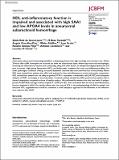Por favor, use este identificador para citar o enlazar a este item:
http://hdl.handle.net/10261/350616COMPARTIR / EXPORTAR:
 SHARE SHARE
 CORE
BASE CORE
BASE
|
|
| Visualizar otros formatos: MARC | Dublin Core | RDF | ORE | MODS | METS | DIDL | DATACITE | |

| Título: | HDL anti-inflammatory function is impaired and associated with high SAA1 and low APOA4 levels in aneurysmal subarachnoid hemorrhage |
Autor: | Ruiz de Azúa-López, Zaida; Pezzotti, María R. CSIC; González-Díaz, Ángela; Meilhac, Olivier; Ureña, Juan CSIC; Amaya-Villar, Rosario CSIC; Castellano, Antonio CSIC ORCID; Varela, Lourdes CSIC ORCID | Palabras clave: | Aneurysmal subarachnoid hemorrhage (aSAH) Apolipoprotein A4 (APOA4) High-density lipoproteins (HDL) Serum amyloid A1 (SAA1) Vascular cell adhesion protein-1 (VCAM-1) |
Fecha de publicación: | nov-2023 | Editor: | Sage Publications | Citación: | Journal of Cerebral Blood Flow & Metabolism 43(11): 1919-1930 (2023) | Resumen: | Aneurysmal subarachnoid hemorrhage (aSAH) is a devastating disease with high morbidity and mortality rates. Within 24 hours after aSAH, monocytes are recruited and enter the subarachnoid space, where they mature into macrophages, increasing the inflammatory response and contributing, along with other factors, to delayed neurological dysfunction and poor outcomes. High-density lipoproteins (HDL) are lipid-protein complexes that exert anti-inflammatory effects but under pathological conditions undergo structural alterations that have been associated with loss of functionality. Plasma HDL were isolated from patients with aSAH and analyzed for their anti-inflammatory activity and protein composition. HDL isolated from patients lost the ability to prevent VCAM-1 expression in endothelial cells (HUVEC) and subsequent adhesion of THP-1 monocytes to the endothelium. Proteomic analysis showed that HDL particles from patients had an altered composition compared to those of healthy subjects. We confirmed by western blot that low levels of apolipoprotein A4 (APOA4) and high of serum amyloid A1 (SAA1) in HDL were associated with the lack of anti-inflammatory function observed in aSAH. Our results indicate that the study of HDL in the pathophysiology of aSAH is needed, and functional HDL supplementation could be considered a novel therapeutic approach to the treatment of the inflammatory response after aSAH. | Descripción: | © The Author(s) 2023. This article is distributed under the terms of the Creative Commons Attribution-NonCommercial 4.0 License (https://creativecommons.org/licenses/by-nc/4.0/) which permits non-commercial use, reproduction and distribution of the work without further permission provided the original work is attributed as specified on the SAGE and Open Access pages (https://us.sagepub.com/en-us/nam/open-access-at-sage). | Versión del editor: | https://doi.org/10.1177/0271678X231184806 | URI: | http://hdl.handle.net/10261/350616 | DOI: | 10.1177/0271678X231184806 | ISSN: | 0271-678X | E-ISSN: | 1559-7016 |
| Aparece en las colecciones: | (IBIS) Artículos |
Ficheros en este ítem:
| Fichero | Descripción | Tamaño | Formato | |
|---|---|---|---|---|
| HDL_JCBFM_2023_OA.pdf | 1,06 MB | Adobe PDF |  Visualizar/Abrir |
CORE Recommender
SCOPUSTM
Citations
1
checked on 20-abr-2024
Page view(s)
18
checked on 30-abr-2024
Download(s)
2
checked on 30-abr-2024
Google ScholarTM
Check
Altmetric
Altmetric
Este item está licenciado bajo una Licencia Creative Commons

